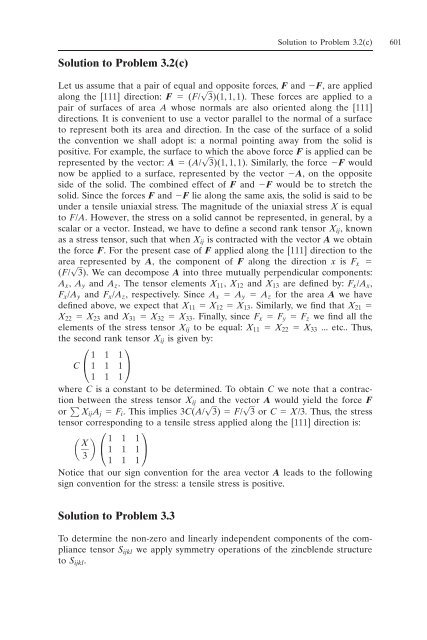10. Appendix
Create successful ePaper yourself
Turn your PDF publications into a flip-book with our unique Google optimized e-Paper software.
Solution to Problem 3.2(c)<br />
Solution to Problem 3.2(c) 601<br />
Let us assume that a pair of equal and opposite forces, F and F, are applied<br />
along the [111] direction: F (F/ √ 3)(1, 1, 1). These forces are applied to a<br />
pair of surfaces of area A whose normals are also oriented along the [111]<br />
directions. It is convenient to use a vector parallel to the normal of a surface<br />
to represent both its area and direction. In the case of the surface of a solid<br />
the convention we shall adopt is: a normal pointing away from the solid is<br />
positive. For example, the surface to which the above force F is applied can be<br />
represented by the vector: A (A/ √ 3)(1, 1, 1). Similarly, the force F would<br />
now be applied to a surface, represented by the vector A, on the opposite<br />
side of the solid. The combined effect of F and F would be to stretch the<br />
solid. Since the forces F and F lie along the same axis, the solid is said to be<br />
under a tensile uniaxial stress. The magnitude of the uniaxial stress X is equal<br />
to F/A. However, the stress on a solid cannot be represented, in general, by a<br />
scalar or a vector. Instead, we have to define a second rank tensor Xij, known<br />
as a stress tensor, such that when Xij is contracted with the vector A we obtain<br />
the force F. For the present case of F applied along the [111] direction to the<br />
area represented by A, the component of F along the direction x is Fx <br />
(F/ √ 3). We can decompose A into three mutually perpendicular components:<br />
Ax, Ay and Az. The tensor elements X11, X12 and X13 are defined by: Fx/Ax,<br />
Fx/Ay and Fx/Az, respectively. Since Ax Ay Az for the area A we have<br />
defined above, we expect that X11 X12 X13. Similarly, we find that X21 <br />
X22 X23 and X31 X32 X33. Finally, since Fx Fy Fz we find all the<br />
elements of the stress tensor Xij to be equal: X11 X22 X33 ... etc.. Thus,<br />
the second rank tensor Xij is given by:<br />
⎛ ⎞<br />
1 1 1<br />
C ⎝ 1 1 1⎠<br />
1 1 1<br />
where C is a constant to be determined. To obtain C we note that a contraction<br />
between the stress tensor Xij and the vector A would yield the force F<br />
or XijAj Fi. This implies 3C(A/ √ 3) F/ √ 3orC X/3. Thus, the stress<br />
tensor corresponding to a tensile stress applied along the [111] direction is:<br />
<br />
X<br />
3<br />
⎛ ⎞<br />
1 1 1<br />
⎝ 1 1 1⎠<br />
1 1 1<br />
Notice that our sign convention for the area vector A leads to the following<br />
sign convention for the stress: a tensile stress is positive.<br />
Solution to Problem 3.3<br />
To determine the non-zero and linearly independent components of the compliance<br />
tensor Sijkl we apply symmetry operations of the zincblende structure<br />
to Sijkl.










